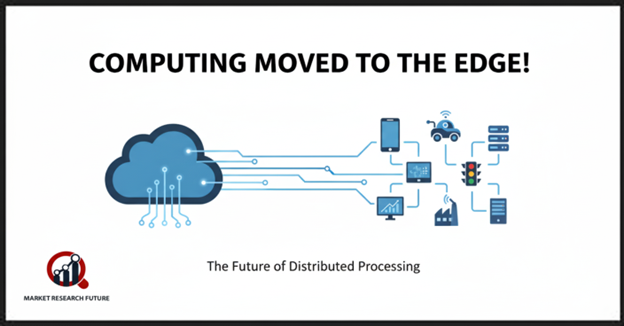Computing Moved to the Edge!

Edge Computing Market Overview
The edge computing industry is rapidly emerging as a transformative force in global IT infrastructure, enabling faster, more secure, and more efficient data processing. Unlike traditional cloud computing, which centralizes data storage and processing, edge computing moves these capabilities closer to the data source — at or near the network edge. This shift significantly reduces latency, improves real-time responsiveness, and enhances security.
What is Edge Computing?
Edge computing is a distributed computing model that relocates data processing and storage closer to the point of data generation — such as sensors, devices, and local servers — rather than relying solely on centralized cloud data centres. By processing data locally, organizations can:
- Reduce network congestion and latency
- Enhance data privacy and security
- Respond instantly to user demands
- Lower bandwidth costs
This localized approach is especially critical in applications requiring real-time performance, such as autonomous vehicles, industrial IoT, smart cities, healthcare monitoring, and augmented reality.
Market Growth Drivers
The growth of the global edge computing market is fueled by several converging trends:
- Proliferation of IoT Devices: With billions of connected devices generating massive data volumes, edge computing enables efficient real-time processing.
- 5G Deployment: Ultra-fast, low-latency 5G networks are accelerating edge computing adoption across telecom, manufacturing, and mobility sectors.
- Demand for Real-Time Insights: Businesses require instant analytics for decision-making, especially in mission-critical environments.
- AI Integration: AI-powered edge solutions enhance automation, predictive maintenance, and intelligent analytics at the data source.
- Cost Efficiency & Security: By reducing data transfer to central clouds, organizations cut bandwidth costs and strengthen data sovereignty.
Key Trends Shaping the Future
- Edge-as-a-Service (EaaS): Cloud providers are offering scalable edge computing platforms, making it easier for businesses to deploy and manage edge environments.
- AI at the Edge: Machine learning models deployed locally enable smarter devices that analyze data instantly, without relying on cloud connectivity.
- 5G and Edge Synergy: The integration of 5G networks with edge infrastructure is unlocking new use cases — from autonomous transport to immersive gaming.
- Edge Security Solutions: Advanced encryption and local data processing minimize risks associated with centralized data storage.
- Industry-Specific Adoption: Sectors such as healthcare, automotive, manufacturing, and retail are increasingly adopting edge solutions for operational efficiency and real-time insights.
Challenges
Despite its promising growth trajectory, the edge computing market faces key challenges:
- High Initial Costs: Infrastructure deployment and integration with legacy systems can be expensive.
- Complex Ecosystems: Managing distributed nodes and ensuring interoperability across networks require sophisticated orchestration.
- Data Security Concerns: While local processing enhances privacy, fragmented architectures can introduce new vulnerabilities.
- Talent Gap: Demand for edge computing specialists and AI engineers exceeds current supply.
Addressing these barriers through standardization, training programs, and strategic partnerships will be crucial for sustainable adoption.
Regional Insights
- North America leads the global edge computing market, supported by robust cloud infrastructure, strong IoT penetration, and early 5G rollout.
- Europe follows with significant investments in industrial IoT and smart manufacturing under Industry 4.0 initiatives.
- Asia-Pacific is the fastest-growing region, driven by massive digital transformation in China, India, Japan, and South Korea.
- Latin America and Middle East & Africa are emerging markets, where smart city projects and telecom advancements are fueling gradual adoption.
Future Outlook
The future of edge computing lies in hybrid and integrated ecosystems, where edge, cloud, and AI technologies seamlessly converge. Businesses will increasingly adopt intelligent edge architectures to enhance automation, predictive analytics, and decision-making capabilities.
As industries embrace decentralized data processing, the focus will shift toward scalability, sustainability, and collaboration across technology providers. With continuous innovation, edge computing will become a core enabler of next-generation digital transformation, powering smarter, faster, and more secure connected ecosystems.
Conclusion
Edge computing represents a paradigm shift in how data is processed, stored, and utilized. By bringing intelligence closer to the source, it empowers organizations with real-time agility, enhanced security, and operational efficiency. As global industries move toward digitally integrated systems, edge computing is set to become a cornerstone of modern IT infrastructure — driving innovation, competitiveness, and value creation across sectors.

Leave a Comment